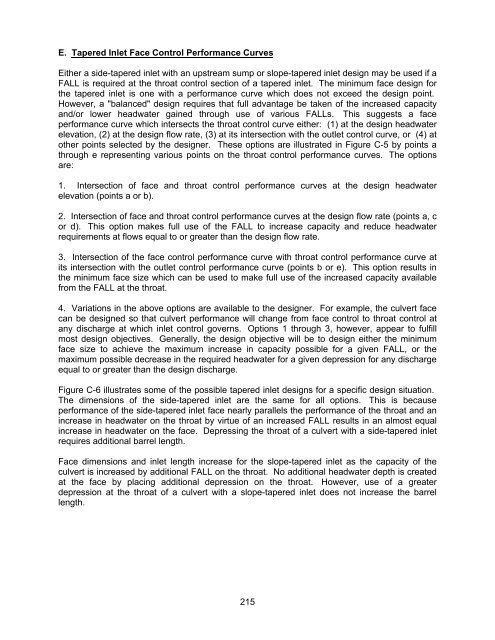Hydraulic Design of Highway Culverts - DOT On-Line Publications
Hydraulic Design of Highway Culverts - DOT On-Line Publications
Hydraulic Design of Highway Culverts - DOT On-Line Publications
Create successful ePaper yourself
Turn your PDF publications into a flip-book with our unique Google optimized e-Paper software.
E. Tapered Inlet Face Control Performance Curves<br />
Either a side-tapered inlet with an upstream sump or slope-tapered inlet design may be used if a<br />
FALL is required at the throat control section <strong>of</strong> a tapered inlet. The minimum face design for<br />
the tapered inlet is one with a performance curve which does not exceed the design point.<br />
However, a "balanced" design requires that full advantage be taken <strong>of</strong> the increased capacity<br />
and/or lower headwater gained through use <strong>of</strong> various FALLs. This suggests a face<br />
performance curve which intersects the throat control curve either: (1) at the design headwater<br />
elevation, (2) at the design flow rate, (3) at its intersection with the outlet control curve, or (4) at<br />
other points selected by the designer. These options are illustrated in Figure C-5 by points a<br />
through e representing various points on the throat control performance curves. The options<br />
are:<br />
1. Intersection <strong>of</strong> face and throat control performance curves at the design headwater<br />
elevation (points a or b).<br />
2. Intersection <strong>of</strong> face and throat control performance curves at the design flow rate (points a, c<br />
or d). This option makes full use <strong>of</strong> the FALL to increase capacity and reduce headwater<br />
requirements at flows equal to or greater than the design flow rate.<br />
3. Intersection <strong>of</strong> the face control performance curve with throat control performance curve at<br />
its intersection with the outlet control performance curve (points b or e). This option results in<br />
the minimum face size which can be used to make full use <strong>of</strong> the increased capacity available<br />
from the FALL at the throat.<br />
4. Variations in the above options are available to the designer. For example, the culvert face<br />
can be designed so that culvert performance will change from face control to throat control at<br />
any discharge at which inlet control governs. Options 1 through 3, however, appear to fulfill<br />
most design objectives. Generally, the design objective will be to design either the minimum<br />
face size to achieve the maximum increase in capacity possible for a given FALL, or the<br />
maximum possible decrease in the required headwater for a given depression for any discharge<br />
equal to or greater than the design discharge.<br />
Figure C-6 illustrates some <strong>of</strong> the possible tapered inlet designs for a specific design situation.<br />
The dimensions <strong>of</strong> the side-tapered inlet are the same for all options. This is because<br />
performance <strong>of</strong> the side-tapered inlet face nearly parallels the performance <strong>of</strong> the throat and an<br />
increase in headwater on the throat by virtue <strong>of</strong> an increased FALL results in an almost equal<br />
increase in headwater on the face. Depressing the throat <strong>of</strong> a culvert with a side-tapered inlet<br />
requires additional barrel length.<br />
Face dimensions and inlet length increase for the slope-tapered inlet as the capacity <strong>of</strong> the<br />
culvert is increased by additional FALL on the throat. No additional headwater depth is created<br />
at the face by placing additional depression on the throat. However, use <strong>of</strong> a greater<br />
depression at the throat <strong>of</strong> a culvert with a slope-tapered inlet does not increase the barrel<br />
length.<br />
215

















